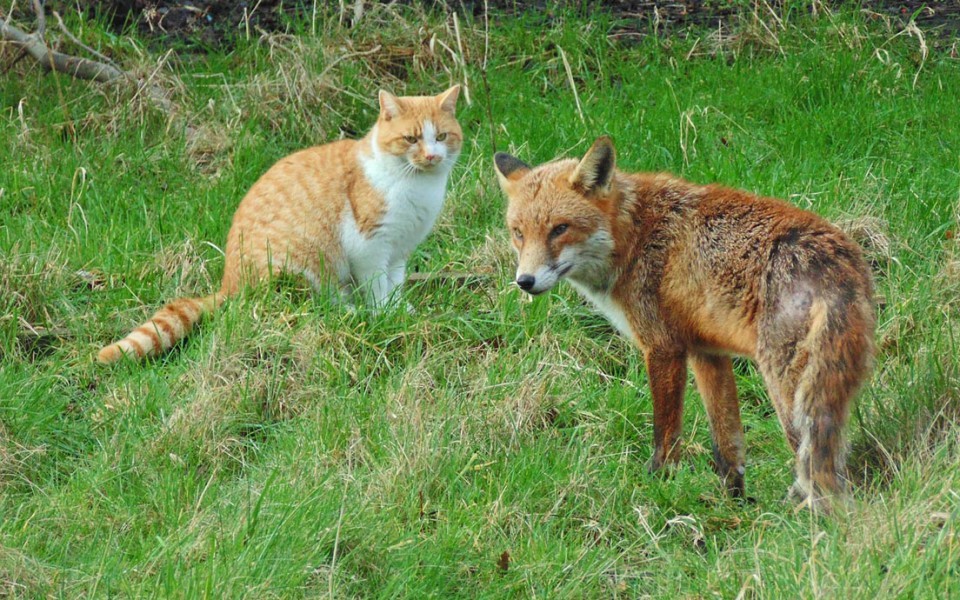Foxes are often described as being about the size of a domestic cat, but how accurate is this comparison, and how do they measure up against dogs? While foxes might seem larger at a distance, their size can be deceptively small. This article delves into the fascinating world of fox size, comparing them to both cats and dogs, and exploring the variations in their dimensions across the globe.
Deciphering Fox Dimensions: Head, Body, and Tail
A fox’s size is typically determined by measuring its head and body length (HBL), excluding the tail (or brush). Globally, most adult foxes have an HBL ranging from 45cm to 90cm (1.5 to 3 feet). Their bushy tails add another 30cm to 50cm (1 to 1.6 feet), bringing their total length to a maximum of about 150cm (just under 5 feet). This makes them roughly the size of a large domestic cat.
In the UK, adult male foxes generally measure between 67cm and 72cm (26 to 28 inches) in HBL, while females are slightly smaller, ranging from 62cm to 68cm (24 to 27 inches). The tail constitutes over a third of their total length, with the longest recorded tail measuring an impressive 55.5cm (almost 2 feet). Interestingly, studies suggest that foxes in Northern Ireland have shorter tails compared to their British counterparts.
Geographic Variations in Fox Size
Research indicates significant regional differences in fox size. North American foxes from Alaska tend to be the largest, while those from California and Georgia are the smallest. In Eurasia, the largest foxes inhabit the Far East, and the smallest are found along the southern borders of the continent. Within Europe, Scandinavian foxes are generally the largest, followed by British foxes.
Comparing Fox Weight to Dogs
Despite their length, foxes are surprisingly lightweight. Their slender leg bones contribute to a weight that is roughly 30% less than a dog of comparable size. In Britain, an adult male fox averages around 6.5kg (14 lbs), with a range of 4kg to 8kg (9 to 17.6 lbs). Females average 5.5kg (12 lbs), ranging from 4kg to 6kg (9 to 13 lbs). North American foxes typically weigh between 3.5kg and 7kg (8 to 15.4 lbs). Globally, the weight range for Red foxes extends from 3kg to a remarkable 16kg (7 to 35 lbs).
Latitude and Body Size: Bergmann’s Rule in Foxes
With few exceptions, Red fox size adheres to Bergmann’s Rule, which states that body size increases with latitude. This means foxes in colder northern regions tend to be larger than those in warmer southern areas. This adaptation may be linked to thermoregulation, as larger bodies retain heat more efficiently in cold environments. Longer legs can also be advantageous in snowy conditions.
“Breeds” of Foxes and Habitat Influence
Historically, different “breeds” of foxes have been described in Britain, often categorized as “upland” and “lowland” varieties. Upland foxes are generally larger, with longer legs and coarser fur, potentially reflecting adaptations to harsher environments and dispersed food sources.
Debunking Myths About Giant Foxes
While anecdotal accounts of exceptionally large foxes exist, they are often attributed to misidentification with certain dog breeds. Confirmed cases of large foxes do occur, with records exceeding 17kg (38 lbs). However, claims of “giant” urban foxes often lack scientific evidence.
Factors Influencing Fox Size: Genes and Environment
Genetic factors, specifically genes controlling growth hormones, primarily determine body size in foxes. However, external factors like food availability and climate can influence hormone production and release. While some studies suggest access to human-provided food may increase skull size in foxes and badgers, conclusive evidence regarding the impact of urbanization on overall fox size remains elusive.
In conclusion, while foxes are generally smaller than most dog breeds, their size exhibits considerable variation depending on geographic location, sex, and individual factors. They are more comparable in size to a domestic cat, although larger specimens can occasionally be found. The complex interplay of genetics and environmental influences continues to shape the fascinating diversity in fox size.
